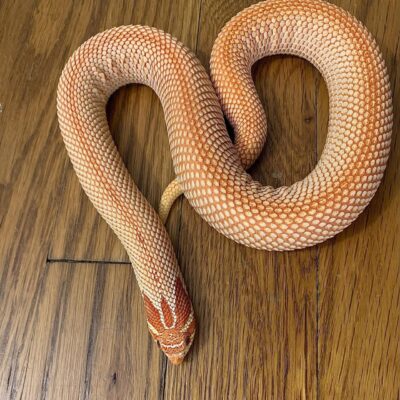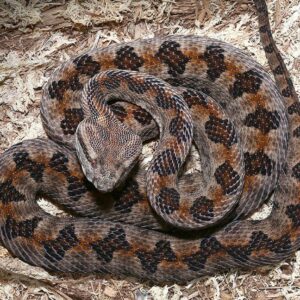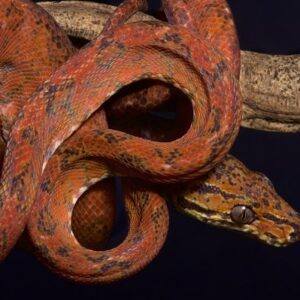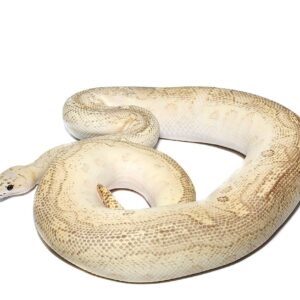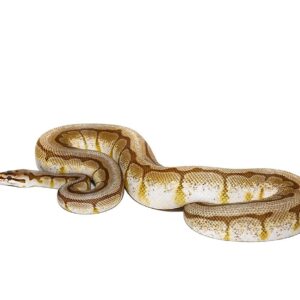Albino Super Anaconda Hognose For Sale
$550.00
We have beautiful Albino Super Anaconda Hognose Snakes available that are captive-bred. Sunset reptiles provides them with in a manner that is appropriate for the size mice. These Albino Super Anaconda Hognose for auction are juveniles and babies, and range from 6 to 6″ long.
Hides
A large enclosure allows you to have additional hiding places that will enable the hognose to keep cover when feeling stressed. You can include a hide on the hot side and the cold front so that the snake can have different options.
Additionally, a large hide is easy to clean and sanitize. However, the hiding place should only accommodate a coiled hognose and not too big that it will not be usable.
You can also include extra items in the enclosure like logs and branches to make a cozy spot for the hognose as you will often see your snake climbing on them. If you decide to keep the snake in a biologically active cage, you can include a nutrient fertile soil and clay mix. We recommend keeping the cage furniture simple.
Also, keep a sturdy, clean water bowl in the snake’s enclosure. It should be dense so that it doesn’t tip over and spill the water. The container should be disinfected regularly and changed every few days.
Description
Albino Super Anaconda Hognose
The Albino Super Anaconda Hognose Snake is a captivating reptile that has garnered significant attention among herpetology enthusiasts. This unique morph stands out due to its striking appearance and distinct genetic makeup. Unlike typical hognose snakes, the Albino Super Anaconda Hognose Snake exhibits a rare combination of traits that make it particularly fascinating.
One of the most notable aspects of the Albino Super Anaconda Hognose Snake is its coloration. As the name suggests, these snakes possess an albino trait, resulting in a lack of pigmentation. This genetic variation gives them a pale, almost translucent appearance, with hues of yellow, pink, and white replacing the usual darker colors seen in other hognose snakes. Their eyes are typically a striking red or pink, contributing to their otherworldly look.
In addition to their unique coloration, the pattern of the Albino Super Anaconda Hognose Snake is another distinguishing feature. The “Super Anaconda” aspect refers to the heavy reduction of patterning, leading to a more uniform and clean appearance. This morph often has fewer and smaller blotches compared to standard hognose snakes, creating a sleek and elegant look. The combination of albino and super anaconda traits results in a visually stunning snake that stands out in any collection.
Size-wise, the Albino Super Anaconda Hognose Snake is comparable to other Western Hognose Snakes, typically reaching lengths of 14 to 24 inches. They possess the characteristic upturned snout of the hognose, which is used for burrowing and hunting in their natural habitat. Despite their somewhat intimidating appearance, these snakes are generally known for their docile nature and can make excellent pets for experienced reptile keepers.
Overall, the Albino Super Anaconda Hognose Snake is a remarkable example of the diversity within the hognose snake species. Its unique combination of albino coloration and reduced patterning sets it apart, making it a highly sought-after morph among snake enthusiasts. The blend of visual appeal and intriguing genetics ensures that this snake will continue to be a subject of fascination and study in the herpetological community.
The hognose snake, belonging to the Heterodon genus, thrives in a variety of habitats across North America. Typically found in sandy, loose soils, these snakes are adept burrowers, utilizing their unique upturned snout to dig and hunt. General habitats include grasslands, woodlands, and scrublands, where they find ample cover and prey. Their ability to adapt to different environments has played a crucial role in their widespread distribution.
Narrowing down to the Albino Super Anaconda Hognose Snake, these snakes are selectively bred variants of the Western Hognose Snake (Heterodon nasicus). This specific morph exhibits a striking albino coloration and distinctive pattern, setting it apart from its wild relatives. In terms of natural habitat, the Albino Super Anaconda Hognose Snake does not occur naturally in the wild; instead, it is a result of controlled breeding programs aimed at enhancing particular genetic traits.
Geographically, the wild Western Hognose Snake is predominantly found in the central United States, extending from southern Canada to northern Mexico. They inhabit regions characterized by dry, sandy, or semi-arid conditions, which facilitate their burrowing behavior. Key states where these snakes are commonly found include Texas, Kansas, Oklahoma, and Nebraska. The environmental conditions they thrive in include open prairies, grasslands, and sandy river valleys that offer both shelter and abundant prey.
For the Albino Super Anaconda Hognose Snake, breeding programs are typically conducted in captivity. Breeders simulate the natural habitat conditions of the wild hognose snakes to ensure optimal health and development. This includes maintaining appropriate temperature gradients, humidity levels, and providing substrates that mimic their natural burrowing environments. The controlled breeding environment ensures that these snakes can flourish while highlighting their unique genetic traits, making them highly sought after by enthusiasts and collectors.
Unique Physical Characteristics
The Albino Super Anaconda Hognose Snake is a striking example of nature’s artistry, distinguished by its unique physical traits. The most immediately noticeable feature is its albino coloration. Unlike the typical hognose snake, which displays a spectrum of brown, black, and olive hues, the albino variant exhibits a captivating palette of white and yellow shades. Its skin lacks melanin, resulting in a delicate and ethereal appearance that sets it apart from its non-albino counterparts.
Another prominent characteristic is the ‘super anaconda’ pattern. This pattern is a series of bold, often irregular, blotches running the length of the snake’s body. These blotches are typically darker shades of yellow or orange, creating a striking contrast against the lighter background. The ‘super’ designation indicates a more pronounced and extensive patterning compared to the standard anaconda morph, making these snakes particularly visually appealing.
The scale texture of the Albino Super Anaconda Hognose Snake also warrants attention. Its scales are keeled, meaning each scale has a raised ridge, giving the snake a rough texture. This feature not only adds to its unique appearance but also provides a tactile experience that differentiates it from smoother-scaled species. The head of the Albino Super Anaconda Hognose Snake is another defining feature. It is characteristically broad and triangular, with a slightly upturned snout. This snout, reminiscent of a shovel, aids in burrowing and is a distinctive trait of the hognose species.
In terms of body length, the Albino Super Anaconda Hognose Snake is relatively moderate in size. Adults typically range from 24 to 36 inches, though some individuals may grow slightly longer. This manageable size, combined with their unique physical characteristics, makes them a popular choice among reptile enthusiasts and collectors. The combination of albino coloration, super anaconda pattern, unique scale texture, and distinct head shape makes the Albino Super Anaconda Hognose Snake a truly fascinating species in the world of herpetology.
Behavior and Temperament
The Albino Super Anaconda Hognose Snake exhibits a distinctive blend of behaviors and temperament that endear it to reptile enthusiasts. Known for their generally docile nature, these snakes are often considered ideal for those new to snake keeping. Unlike some other species, Albino Super Anaconda Hognose Snakes are known to be less aggressive and more tolerant of handling, which makes them a popular choice among pet owners.
One of the most notable behaviors of the Albino Super Anaconda Hognose Snake is its unique feeding habits. These snakes are primarily insectivores in the wild, favoring amphibians and small rodents. In captivity, they readily accept a diet of appropriately-sized frozen-thawed mice. It’s important to note that these snakes can sometimes be finicky eaters, particularly during shedding or breeding seasons. Owners should observe their feeding patterns closely to ensure they are consuming adequate nutrition.
Activity levels in Albino Super Anaconda Hognose Snakes are relatively moderate. They are known to be more active during dawn and dusk, exhibiting crepuscular tendencies. During these times, they can be seen exploring their enclosures, burrowing, and engaging in other natural behaviors. Providing an environment that mimics their natural habitat, with plenty of hiding spots and substrate for burrowing, is crucial for their mental and physical health.
Unique behaviors such as “hooding” and playing dead are also characteristic of the Albino Super Anaconda Hognose Snake. When threatened, they may flatten their necks and hiss, mimicking a cobra’s defensive posture. If this doesn’t deter a perceived threat, they might roll over and play dead, a dramatic display that can be quite startling for the uninitiated observer. These behaviors, while fascinating, are typically rare in a well-adjusted captive snake.
Comparatively, the temperament of the Albino Super Anaconda Hognose Snake is often more relaxed than other hognose snake varieties. Their striking appearance, coupled with their manageable behavior, makes them a sought-after species among reptile enthusiasts. Understanding these behaviors and temperament traits can help owners provide the best care and environment for their Albino Super Anaconda Hognose Snake.
Diet and Feeding Requirements
The Albino Super Anaconda Hognose Snake, like its non-albino counterparts, has specific dietary needs that are essential for its health and well-being. In the wild, these snakes are known to prey on a variety of small animals, including amphibians, rodents, and lizards. Their natural inclination towards amphibians such as frogs and toads is particularly noteworthy, as these prey items provide the necessary nutrients that the snake requires for optimal growth and health.
For those keeping Albino Super Anaconda Hognose Snakes in captivity, replicating their natural diet as closely as possible is crucial. Generally, frozen-thawed rodents are the most commonly recommended food source for these snakes. Mice and small rats are typically ideal, as they are readily available and offer balanced nutrition. It is important to ensure that the prey items are appropriately sized; a good rule of thumb is to offer prey that is about the same width as the snake’s widest part.
Feeding frequency varies depending on the snake’s age and size. Juvenile Albino Super Anaconda Hognose Snakes should be fed once every 5-7 days, while adult snakes may only require feeding once every 10-14 days. Overfeeding can lead to obesity and other health issues, so it is essential to monitor the snake’s body condition and adjust feeding schedules accordingly.
Special dietary considerations include ensuring the prey is thoroughly thawed and warmed to a temperature that mimics a live animal, which stimulates the snake’s natural feeding response. Additionally, it is advisable to occasionally vary the diet by offering amphibians or fish to mimic their natural dietary diversity, although this should not be the mainstay of their diet.
Proper feeding practices are integral to maintaining the health and longevity of the Albino Super Anaconda Hognose Snake. By understanding and meeting their dietary needs, keepers can ensure their snakes thrive in captivity.
Care and Housing in Captivity
When caring for an Albino Super Anaconda Hognose Snake in captivity, it is crucial to replicate its natural habitat to ensure its well-being and longevity. The first consideration is the size of the enclosure. A 20-gallon tank is suitable for a young or small snake, but adult Albino Super Anaconda Hognose Snakes require at least a 40-gallon tank to move and explore comfortably.
Temperature regulation is vital for the snake’s health. The enclosure should provide a thermal gradient, with a basking spot maintained at 88-90°F and a cooler end around 75-80°F. Using a thermostat-controlled heat mat or ceramic heat emitter can help achieve and maintain these temperatures. Nighttime temperatures can safely drop to around 70°F. Additionally, it is essential to monitor the humidity levels within the enclosure. This species thrives in moderate humidity, ideally between 40-60%. Utilizing a hygrometer can help to keep track of these levels.
Choosing the right substrate is another critical aspect of care. Aspen bedding or cypress mulch are excellent options as they allow the snake to burrow, mimicking its natural environment. Avoid using substrates like sand or cedar, which can cause respiratory or digestive issues.
The enclosure should also be furnished with essential items to make the snake feel secure and reduce stress. Provide multiple hiding spots, such as small caves or hollow logs, at both the warm and cool ends of the tank. Additionally, a shallow water dish is necessary for drinking and soaking; ensure it is frequently cleaned and refilled with fresh water. Incorporating natural décor such as branches, rocks, and artificial plants can help create a more stimulating and naturalistic environment.
By following these best practices for enclosure size, temperature, humidity, substrate, and necessary furnishings, one can create a comfortable and healthy living space for an Albino Super Anaconda Hognose Snake in captivity.
Health and Common Issues
The Albino Super Anaconda Hognose Snake, like any other reptile, is susceptible to various health issues that can impact its overall well-being. One of the most common ailments affecting these snakes is respiratory infections. Signs of a respiratory infection include wheezing, bubbling around the nostrils, and an open-mouth breathing pattern. Prompt veterinary care is essential if these symptoms are observed, as untreated respiratory infections can become severe.
Another prevalent health issue is parasitic infestation. Internal parasites, such as worms, and external parasites, like mites, can cause significant distress and health deterioration. Symptoms of parasitic infestation include lethargy, irregular shedding, and loss of appetite. Regular cleaning of the snake’s habitat and periodic veterinary check-ups are effective preventive measures. Additionally, ensuring proper humidity and temperature levels within the enclosure can prevent many health problems related to poor husbandry.
Metabolic bone disease (MBD) is a serious condition caused by calcium deficiency, often due to inadequate UVB lighting or an imbalanced diet. Symptoms of MBD include deformities, tremors, and lethargy. Prevention involves providing a well-balanced diet rich in calcium and ensuring appropriate exposure to UVB light. Snake owners should consult with a reptile veterinarian for dietary recommendations and proper lighting setups.
Stress is another factor that can lead to various health issues in Albino Super Anaconda Hognose Snakes. Signs of stress include erratic behavior, refusal to eat, and frequent hiding. To minimize stress, it’s crucial to maintain a consistent environment with minimal disturbances and handle the snake gently and infrequently.
Regular observation is vital in maintaining the health of the Albino Super Anaconda Hognose Snake. Owners should monitor their pet for any signs of illness, changes in behavior, or irregularities in the snake’s physical appearance. Establishing a routine of preventive care, including regular veterinary visits, proper diet, and a clean and suitable habitat, will greatly enhance the snake’s health and longevity. When in doubt, seeking professional veterinary assistance is always the best course of action to ensure the well-being of these fascinating reptiles.
Breeding and Genetics
Breeding the Albino Super Anaconda Hognose Snake involves a detailed understanding of both genetics and husbandry practices. The albino and super anaconda traits are inherited through specific genetic pathways. Albino hognose snakes exhibit a recessive trait, meaning that both parents must carry the albino gene for the offspring to express this characteristic. The super anaconda pattern, on the other hand, is a codominant trait, resulting in a distinctive, reduced patterning when one copy of the gene is present.
Successful breeding requires careful selection of breeding pairs. For instance, to produce an Albino Super Anaconda Hognose Snake, breeders typically pair an albino hognose snake with a super anaconda hognose snake that also carries the albino gene. This combination maximizes the likelihood of offspring expressing both desired traits. Genetic testing can be an invaluable tool in confirming the genetic makeup of breeding snakes, ensuring that the desired traits are passed on to the next generation.
The breeding process itself demands meticulous attention to detail. Breeders must ensure optimal environmental conditions, such as appropriate temperature and humidity levels, to encourage successful mating and healthy egg development. Once eggs are laid, they require incubation at specific temperatures to ensure proper development. The incubation period typically lasts around 50 to 60 days.
Challenges in breeding Albino Super Anaconda Hognose Snakes include managing genetic diversity to avoid inbreeding and ensuring that hatchlings are healthy and robust. Breeders should also be prepared for the potential of genetic anomalies or health issues that can arise from intensive breeding practices. It’s crucial to monitor the health of both the breeding pairs and their offspring closely.
For those interested in breeding these snakes, it is beneficial to seek mentorship from experienced breeders and to continuously educate oneself on the latest genetic research and breeding techniques. Patience, dedication, and a thorough understanding of hognose snake genetics will contribute significantly to successful breeding outcomes.
